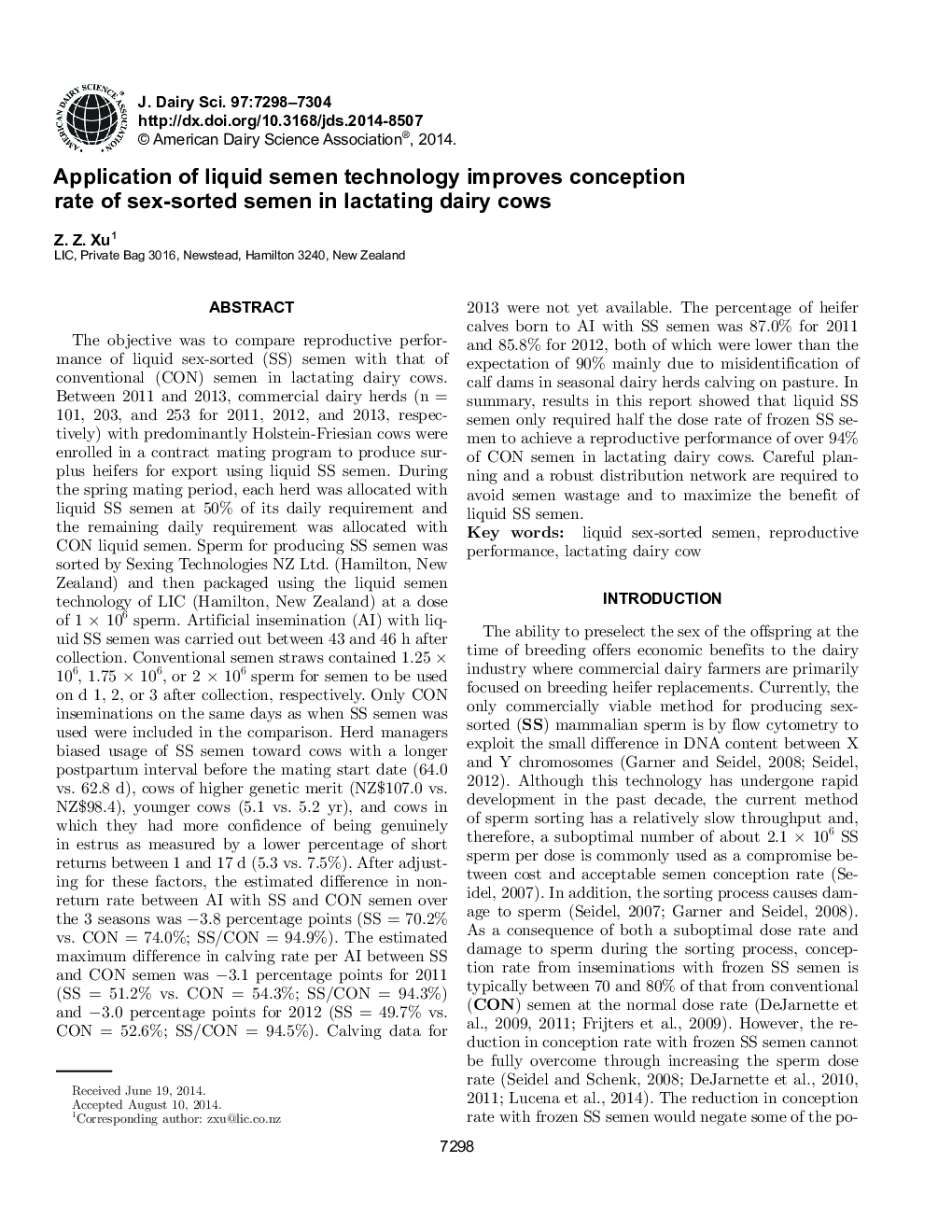| کد مقاله | کد نشریه | سال انتشار | مقاله انگلیسی | نسخه تمام متن |
|---|---|---|---|---|
| 10976963 | 1108045 | 2014 | 7 صفحه PDF | دانلود رایگان |
عنوان انگلیسی مقاله ISI
Application of liquid semen technology improves conception rate of sex-sorted semen in lactating dairy cows
ترجمه فارسی عنوان
استفاده از تکنولوژی اسپرم مایع میزان تخمک گذاری اسپرم های مرتب شده جنسی را در گاوهای شیرده افزایش می دهد
دانلود مقاله + سفارش ترجمه
دانلود مقاله ISI انگلیسی
رایگان برای ایرانیان
کلمات کلیدی
مننژیت مایع جنسی مرتب شده، عملکرد تولید مثل، گاو شیری شیرده،
موضوعات مرتبط
علوم زیستی و بیوفناوری
علوم کشاورزی و بیولوژیک
علوم دامی و جانورشناسی
چکیده انگلیسی
The objective was to compare reproductive performance of liquid sex-sorted (SS) semen with that of conventional (CON) semen in lactating dairy cows. Between 2011 and 2013, commercial dairy herds (n = 101, 203, and 253 for 2011, 2012, and 2013, respectively) with predominantly Holstein-Friesian cows were enrolled in a contract mating program to produce surplus heifers for export using liquid SS semen. During the spring mating period, each herd was allocated with liquid SS semen at 50% of its daily requirement and the remaining daily requirement was allocated with CON liquid semen. Sperm for producing SS semen was sorted by Sexing Technologies NZ Ltd. (Hamilton, New Zealand) and then packaged using the liquid semen technology of LIC (Hamilton, New Zealand) at a dose of 1 Ã 106 sperm. Artificial insemination (AI) with liquid SS semen was carried out between 43 and 46 h after collection. Conventional semen straws contained 1.25 Ã 106, 1.75 Ã 106, or 2 Ã 106 sperm for semen to be used on d 1, 2, or 3 after collection, respectively. Only CON inseminations on the same days as when SS semen was used were included in the comparison. Herd managers biased usage of SS semen toward cows with a longer postpartum interval before the mating start date (64.0 vs. 62.8 d), cows of higher genetic merit (NZ$107.0 vs. NZ$98.4), younger cows (5.1 vs. 5.2 yr), and cows in which they had more confidence of being genuinely in estrus as measured by a lower percentage of short returns between 1 and 17 d (5.3 vs. 7.5%). After adjusting for these factors, the estimated difference in nonreturn rate between AI with SS and CON semen over the 3 seasons was â3.8 percentage points (SS = 70.2% vs. CON = 74.0%; SS/CON = 94.9%). The estimated maximum difference in calving rate per AI between SS and CON semen was â3.1 percentage points for 2011 (SS = 51.2% vs. CON = 54.3%; SS/CON = 94.3%) and â3.0 percentage points for 2012 (SS = 49.7% vs. CON = 52.6%; SS/CON = 94.5%). Calving data for 2013 were not yet available. The percentage of heifer calves born to AI with SS semen was 87.0% for 2011 and 85.8% for 2012, both of which were lower than the expectation of 90% mainly due to misidentification of calf dams in seasonal dairy herds calving on pasture. In summary, results in this report showed that liquid SS semen only required half the dose rate of frozen SS semen to achieve a reproductive performance of over 94% of CON semen in lactating dairy cows. Careful planning and a robust distribution network are required to avoid semen wastage and to maximize the benefit of liquid SS semen.
ناشر
Database: Elsevier - ScienceDirect (ساینس دایرکت)
Journal: Journal of Dairy Science - Volume 97, Issue 11, November 2014, Pages 7298-7304
Journal: Journal of Dairy Science - Volume 97, Issue 11, November 2014, Pages 7298-7304
نویسندگان
Z.Z. Xu,
